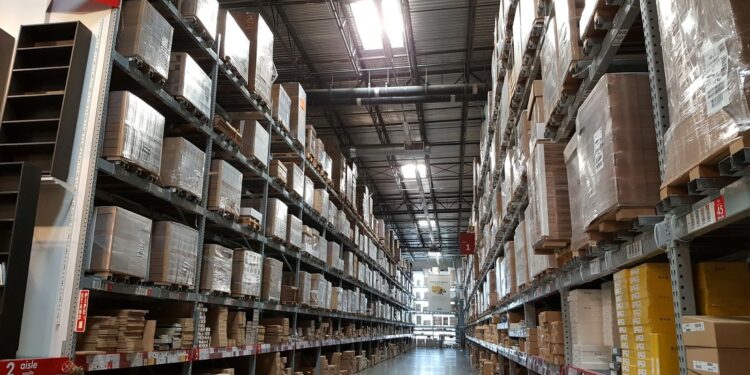A well-optimized warehouse layout is crucial for ensuring smooth operations, maximizing storage space, and improving overall productivity. Whether you’re designing a warehouse from scratch or optimizing an existing one, careful planning creates a high-performing space.
The layout of your warehouse can directly impact efficiency, safety, and the speed at which goods move through your facility. To help you achieve the best results, here are eight tips for creating a warehouse layout that maximizes performance and minimizes downtime — look no further!
Utilize Vertical Space Efficiently
Maximizing vertical space is one of the most effective ways to increase storage capacity without expanding the warehouse’s footprint. Installing mezzanine levels can significantly boost the amount of usable space for storing goods or equipment. Mezzanine platforms offer a cost-effective solution for businesses that need more room but don’t want to invest in a full-scale warehouse expansion. Companies like https://www.kabtechusa.com/ offer warehouse mezzanine solutions that are customizable and adaptable to various needs, providing additional storage, office space, or even equipment areas. When you take advantage of vertical storage solutions, you can increase your warehouse’s overall capacity, improve organization, and reduce the time workers spend navigating the warehouse floor.
Prioritize Product Flow and Accessibility
An efficient warehouse layout should prioritize product flow so that goods can move through the facility in a logical and efficient manner. The goal is to reduce the distance products travel between receiving, storage, picking, and shipping areas. You can achieve this by organizing products based on their turnover rate—store fast-moving items near the front of the warehouse for easy access while slower-moving items can be stored further back.
When designing the layout, consider the movement of forklifts and other equipment to ensure clear, unobstructed pathways. Make sure aisles are wide enough for vehicles to pass through safely and that loading docks are positioned for quick and efficient loading and unloading.
Implement a Cross-Docking Strategy
Cross-docking is a warehouse strategy that involves moving incoming goods directly to the shipping area without storing them in inventory. This method can help improve efficiency, reduce storage costs, and speed up the time it takes to get products out the door. For this strategy to work effectively, your warehouse layout should have a dedicated area for cross-docking that’s easily accessible from both the receiving and shipping docks.
Cross-docking is particularly useful for businesses that handle perishable goods or time-sensitive shipments. If you reduce the amount of time products spend in storage, you can enhance product quality and customer satisfaction.
Design for Safety and Ergonomics
Safety should always be a top priority when designing a warehouse layout. A well-designed space reduces the risk of accidents and promotes a safer working environment. First, ensure that the aisles are wide enough to accommodate equipment like forklifts and that pathways are clearly marked to prevent collisions.
Ergonomics also play a significant role in warehouse efficiency. Designing workstations with ergonomic considerations can reduce worker fatigue and the risk of injury. Place frequently picked items at waist level to minimize bending or reaching, and ensure that shelving units are at appropriate heights to prevent strain. Prioritize safety and ergonomics, and you’ll create a more comfortable and productive environment for your employees.
Implement a Zoning System
Creating zones within your warehouse can help streamline operations and improve efficiency. Each zone should serve a specific function, such as receiving, storage, packing, or shipping. Within the storage zone, you can further divide areas based on product categories or turnover rates (fast-moving vs. slow-moving items).
Implementing a zoning system makes it easier for workers to locate items, reduces travel time, and keeps the warehouse organized. It also allows you to tailor each zone’s layout to suit its specific purpose, optimizing workflow and improving overall efficiency.
Leverage Technology for Inventory Management
The right technology aims to optimize warehouse operations. Implementing a warehouse management system (WMS) can help you track inventory, manage picking and packing, and streamline overall workflow. A WMS allows you to monitor stock levels in real-time, reducing the risk of overstocking or understocking and ensuring that products are stored and retrieved efficiently.
Barcoding and RFID (radio-frequency identification) systems can further enhance inventory management by enabling faster and more accurate tracking of goods. These technologies help reduce errors in picking and packing, improve order accuracy, and increase overall productivity.
Plan for Future Growth and Scalability
Your warehouse layout should not only meet your current needs but also be flexible enough to accommodate future growth. Consider designing your layout with scalability in mind by incorporating modular shelving systems, adjustable racking, or mezzanines that can be expanded as needed. This will allow you to easily reconfigure your warehouse to adapt to changing inventory levels or business demands.
Planning for growth also involves considering how new technologies or automation systems could be integrated into your warehouse layout in the future. Once you leave room for expansion, you can avoid costly renovations or relocations down the line.
Optimize Picking Processes
Picking is one of the most time-consuming tasks in a warehouse, so optimizing this process is essential for improving overall efficiency. You can use methods such as batch picking, zone picking, or wave picking to streamline operations and reduce the time workers spend retrieving items.
Place popular items in easily accessible locations near the packing and shipping areas to minimize the distance pickers need to travel. Using pick-to-light or voice-picking technology can also enhance the accuracy and speed of the picking process, further boosting productivity.
Extra Tip: Regularly Review and Optimize Your Layout
Warehouse needs and operations can evolve over time due to changes in inventory levels, product lines, or customer demands. To ensure that your layout continues to perform at its best, regularly review and adjust your warehouse design as needed. Conduct periodic audits to assess the efficiency of your current layout, analyze any bottlenecks or inefficiencies in workflow, and gather feedback from warehouse staff who interact with the space daily.
If you stay proactive and make adjustments when necessary, you can continue optimizing your warehouse layout to align with changing business needs. This ongoing improvement process helps you maintain a high-performing, adaptable warehouse environment.
Achieving a high-performing warehouse layout involves careful planning and consideration of factors such as product flow, space utilization, and safety. By implementing vertical storage solutions like mezzanines, optimizing picking processes, and using technology to manage inventory, you can create a more efficient and scalable warehouse that meets the demands of your business. Following these tips will help you maximize space and efficiency and improve overall safety and productivity within your warehouse.






